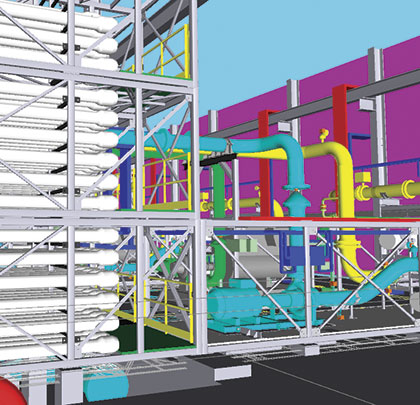In part 1 of this series, we began a discussion of a seawater desalination process that takes the boron removal issue to the edge, using four desalination stages and a downstream boron ion exchanger that removes the boron to an undetectable level of less than 0.01 mg/l of boron. In this month’s conclusion, we close out with a look at membrane boron removal and boron removal by ion exchanger, as well as control and instrumentation issues.
MEMBRANE BORON REMOVAL
The quantity of boron in seawater changes from one location to another, as well as during the year in the same location. The level can be 3 mg/l in some places, and 5.5 mg/l in others. While the polyamide membrane can reject boron from the permeate water, it does not do this efficiently, since the boron in the water behaves similarly to the dissociation of carbonic acid. At low pH, the boron is in the form of boric acid H3BO3, and the rejection of the boric acid by the membranes is limited. Therefore, in seawater with a pH of 8.2, a lower level of boron rejection is expected in the first pass. Due to the presence of Calcium, magnesium and bicarbonate, the pH of the water cannot be controlled, since calcium carbonate and other forms of magnesium and calcium might precipitate on the membrane.
The second RO membrane pass opens the way for a more sophisticated method of boron removal. By increasing the pH to 10.5, a new form of boron becomes dominant in the water—the boric ion H2BO3. Increasing the pH level means that more hydroxide ions (OH-) were added to the water, resulting in an unbalance of the electrical neutrality of the water. More hydrogen ions (H+) are required to balance the water. These ions are taken from the boric acid, thus forming the boric ion. The second pass membrane can now easily reject far more boron, since the membrane has better rejection of monovalent ions. This rejection is further increased by the effect of the electrical field of the membrane, which rejects negative ions better due to the repulsion forces.
Smart management of different streams of water from the membrane can provide permeate water with less than 0.2 mg/l of boron. The design is challenged not only by the boron rejection, but also by the feed temperature. The plant is designed to work at maximum feed temperature of 104 degrees Fahrenheit (40 degrees Celsius), at which temperature the rejection of all ions decreases. To compensate for the low rejection due to temperature, an additional RO stage is implemented.
BORON REMOVAL BY ION EXCHANGER
As previously described, despite the limited boron rejection, a level of 0.2 mg/l of boron in the permeate can be achieved. This level is sufficient for agriculture, but not for the semiconductor industry. To reach the level of 0.01 mg/l of boron, a robust battery of selective boron removal ion exchangers was designed downstream of the RO permeate. The selective ion exchangers were designed to work in counter flow mode with the entire stream of desalinated water, while the chemical regeneration is done in the opposite direction. The selective ion exchanger absorbs the boron. Contrary to the membrane, the acidic form of the boron is best absorbed. This form of boron exists at a pH of 6 to 8, where all the boron is in the form of boric acid H3BO3.
This configuration was selected after economic evaluation of Capex vs. Opex. Twice a year it is necessary to backwash the resin packed bed outside the ion exchanger vessel in order to clean all particles of resin from the packed bed.
CONTROL AND INSTRUMENTATION
A robust and accurate control system is necessary to implement the proposed process design. The entire plant is fully automatic and controlled by a DCS. Special focus is given to the pH control, which is individual to each skid, allowing online pH monitoring with a special algorithm that has been implemented in all IDE plants. Removing boron to an undetectable level is not only a process challenge, but also a control and monitoring challenge due to the accuracy of the measurement required and the unique low level of boron to be controlled.
As vice president of engineering at IDE, Jacky Ben Yaish bears overall responsibility for the engineering design of all IDE products, including both thermal and RO desalination, with the thermal and membrane process departments, as well as the detailed engineering, falling under his responsibility. Jacky has been closely involved in the engineering of the company’s leading mega projects around the world, among them the Sorek, Carlsbad, Tianjin, and Jamnagar plants. Jacky brings twenty-three years of experience in desalination to the management table, from all aspects of the project—process, detailed design, and project management. His across the board experience in all stages of project, from design through to commissioning and operation, provides an unparalleled understanding of complex water treatment projects. He has a broad understanding of alliancing and risk/reward compensation processes associated with alliance. Jacky is a graduate of Ben Gurion University with bachelor and master degrees in mechanical engineering. He also has an MBA from Bar Ilan University, with a focus in financing.
____________________________________________
MODERN PUMPING TODAY, January 2018
Did you enjoy this article?
Subscribe to the FREE Digital Edition of Modern Pumping Today Magazine!
![]()



